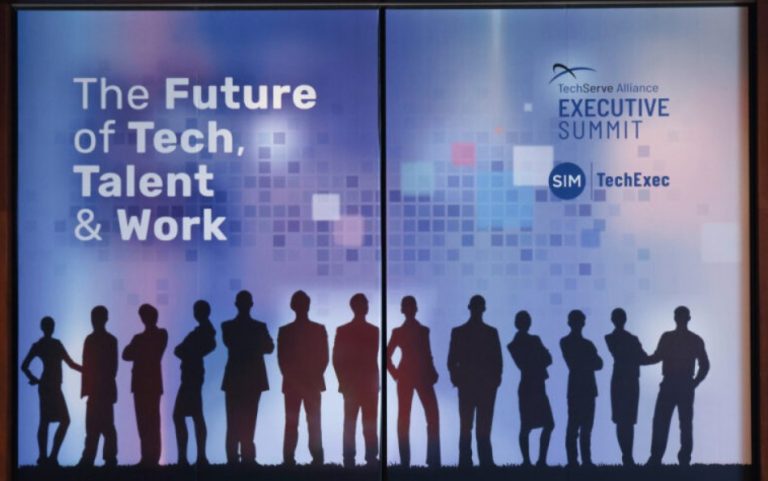The 2025 TechServe Alliance Executive Summit, held November 4–6 at the JW Marriott Marco Island Beach Resort in Florida, brought together more than 400 professionals from across the IT & Engineering staffing and solutions industry. Executives, owners, and technology leaders convened for three days of forward-looking discussion, data-driven insight, and strategic reflection.
Held in partnership with SIM TechExec, the Executive Summit fostered collaboration between staffing and technology executives navigating a shared landscape of disruption, innovation, and workforce transformation.
Across keynote addresses and general sessions, speakers emphasized a central theme: leading through upheaval requires agility, data-informed decision-making, and a renewed focus on people. From the opening remarks to the closing session, the message was consistent—success today demands clarity of vision and the courage to adapt.
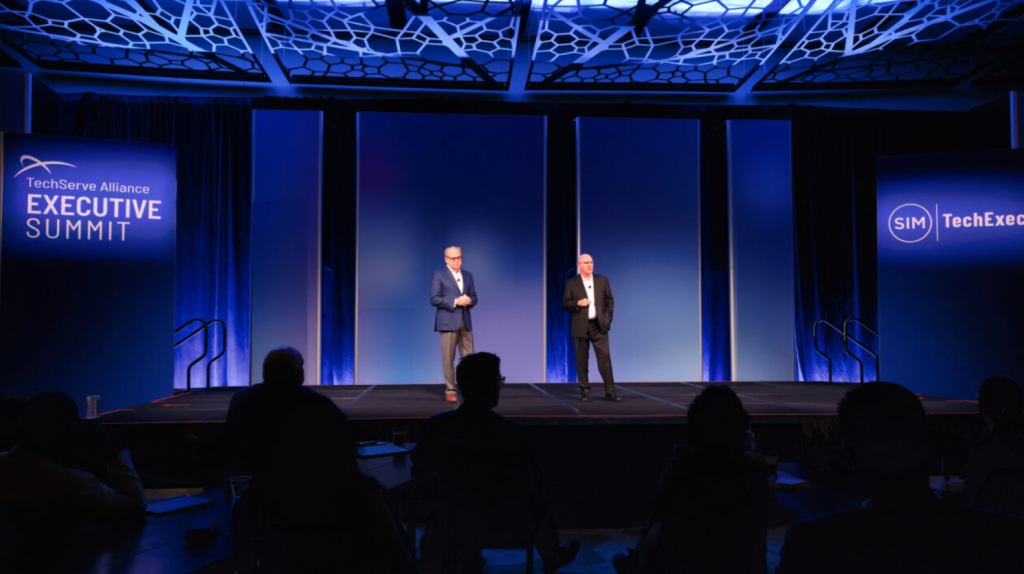
Decision-Making Under Uncertainty
Opening the joint conference, Mark Roberts, CEO of TechServe Alliance, and Mark Taylor, CEO of Society for Information Management (SIM), set the tone with a conversation on leadership, risk, and resilience—using one of the most debated moments in sports history to make their point. Drawing a parallel between Pete Carroll’s infamous Super Bowl XLIX play call and the daily challenges faced by business leaders, they urged attendees to separate the quality of a decision from its outcome.
“A decision is a choice made with sound reasoning—regardless of the eventual result,” Taylor noted. “The outcome may not reflect the quality of the decision.”
In an era defined by volatility, Roberts emphasized that the real challenge for leaders is not uncertainty itself but how they respond to it. “Our goal,” he said, “should be to constantly improve our decision-making process—seeking more data and adjusting based on what we learn.”
Their discussion touched on the accelerating pace of change in technology and the economy. From the lingering effects of inflation to the influence of AI and automation, leaders, they argued, must decide when to play offense and when to play defense. Nearly half of attendees in the live poll identified themselves as “on offense”—a sign of optimism that Roberts called “a testament to this industry’s ability to find opportunity even in headwinds.”
The pair also introduced the Summit’s four key pillars—strategy, technology, workforce, and leadership—themes that would echo throughout the sessions to come. “At SIM,” said Taylor, “we focus on strategy, technology, and leadership. Partnering with TechServe adds the critical fourth pillar: workforce. Together, those pillars define how organizations will thrive in this environment.”
Leading from the Epicenter
Continuing the conversation on leadership, DeMaurice Smith took the stage to explore what it means to lead amid turbulence and uncertainty. Drawing on his fifteen years as Executive Director of the NFL Players Association—including during the historic 2011 lockout—Smith challenged leaders to recognize that disruption is not an exception, but the environment in which leadership is forged.
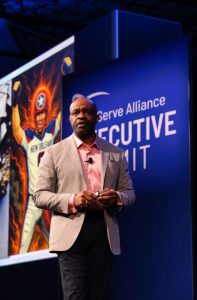
“There is never a better time to develop leaders than in the middle of disruption,” Smith said. “The turbulence is always there—real leaders simply learn to lean into it.”
Through vivid personal stories and lessons from his time negotiating against NFL ownership, Smith underscored the need for courage and conviction in the face of volatility. He described leadership as both a calling and a shared destiny, requiring executives to find stability when “the ground beneath you is shifting.”
“Disruption will be the thing that we breathe,” he explained. “Courage will be the oxygen we use. And execution—not excuses—will define us as leaders.”
Smith’s framework for leadership—anchored in mission, passion, and purpose—resonated deeply with attendees facing similar pressures to adapt and inspire amid change. Whether recalling moments of intense labor negotiation or reflecting on his years as a homicide prosecutor, his message remained clear: effective leadership is not about avoiding upheaval, but about embracing it with clarity and resolve.
“We can’t control the chaos,” Smith said. “But we can decide how we lead through it.”
The State of the Labor Economy
In one of the most anticipated sessions of the Summit, labor economist Ron Hetrick, Principal Economist, Lightcast, University of Florida, unpacked the structural challenges shaping the American workforce. His message was clear: talent shortages are not a temporary phase—they are the new normal.
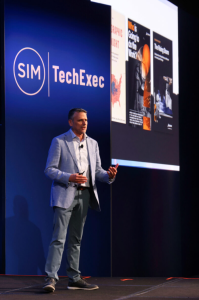
Drawing from decades of labor market data, Hetrick described a demographic shift that has left employers struggling to fill roles across industries, particularly in technology and engineering. “We have fewer workers entering the labor force than leaving it,” he explained. “That imbalance will define the next decade of hiring.”
Hetrick highlighted how, despite pockets of economic slowing, the underlying supply of skilled workers continues to lag far behind demand. The tight labor market that emerged during the pandemic, he noted, has not corrected—it has restructured.
“Even in periods of slower job growth, the problem isn’t demand—it’s supply,” he said. “The U.S. is running out of workers, not out of work.”
He cautioned staffing leaders not to mistake recent hiring pauses for relief. “When growth returns, the fight for talent will be even more intense,” Hetrick warned. “Firms that wait to rebuild pipelines will find themselves behind.”
For the IT & Engineering staffing community, his insights underscored the urgency of proactive workforce planning, reskilling initiatives, and creative sourcing strategies. “The demographics don’t bend,” he said. “The only question is how we adapt.”
Recoding Business: The New Logic for Winning in the AI Era
If data and workforce defined the current reality, AI defined the future. In his keynote address, Vijay Gurbaxani explored how artificial intelligence is transforming the fundamental logic of business—from how organizations create value to how leaders make strategic choices.

“AI is not simply another technology—it’s a new factor of production,” Gurbaxani said. “It changes what’s possible, what’s profitable, and what’s required of leadership.”
He urged executives to move beyond experimentation and focus on integration, arguing that the next wave of competitive advantage will come from combining human judgment with AI-driven insight. “The winning firms,” he explained, “are those that don’t see AI as replacing people, but as amplifying their capabilities.”
Gurbaxani outlined three imperatives for success in the AI era: redefine business processes around automation and data-driven agility, invest in digital literacy at every level of the organization, and align culture and governance to support innovation and ethical AI use.
He noted that while hype cycles come and go, the underlying transformation is permanent. “In every technological revolution,” he said, “the organizations that thrive are those that recode their logic before they’re forced to.”
For staffing leaders, that means not only adopting AI internally, but helping clients navigate the same disruption. “Talent strategy and technology strategy,” he emphasized, “are now one and the same.”
A Monster Story: Reinventing How We Connect People and Opportunity
Closing the conference, Jeff Taylor delivered an energetic and candid reflection on innovation, disruption, and reinvention—drawing lessons from his experience founding Monster.com and his newest venture, Boom Band.
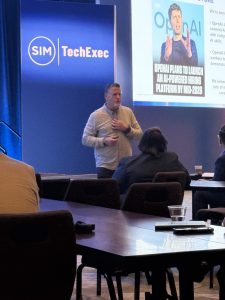
Taylor opened with a story that has become legend in HR technology: the birth of the first online job board in 1993. “When I told people I was going to call my company Monster,” he recalled with a smile, “everyone said it was a terrible idea. Even my wife said she wouldn’t leave the house with me if I did.”
The laughter gave way to insight as Taylor reflected on the enduring need for change. “We built an entire industry,” he said. “But three decades later, the systems are broken. Job seekers apply for hundreds of roles and hear nothing. Recruiters are overwhelmed by noise. It’s time to reinvent how we connect people and opportunity.”
Drawing parallels between the early internet and today’s AI explosion, Taylor noted that both moments share a mix of hype, investment, and transformation. “History doesn’t duplicate—but it rhymes,” he said. “In 1994 it was the browser. In 2025, it’s AI. Both changed everything.”
Taylor’s vision for the future is one of personalization and human connection, powered—not replaced—by technology. “The resume hasn’t changed in a hundred years,” he argued. “We need tools that reflect who people are today, not just what they’ve done.”
He closed with a challenge to leaders: embrace experimentation, move faster, and stay uncomfortable. “If you don’t start thinking about this differently,” he warned, “someone else will do it for you.”
Conclusion: Rethinking the Playbook
Across all five keynotes, a common thread emerged—leadership in today’s environment means making bold decisions amid uncertainty. Whether it’s evaluating data and instinct, confronting demographic headwinds, embracing AI, or reimagining the candidate experience, the path forward demands both clarity and courage.

At the 2025 TechServe Alliance Executive Summit, industry voices converged around one truth: disruption is inevitable, but decline is not. Those who adapt, learn, and lead with purpose will define the next chapter of the IT & Engineering staffing industry.







